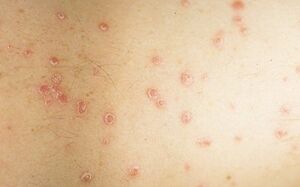According to official data, about 3% of people globally suffer from psoriasis. But it must be assumed that the actual number of patients with this type of dermatological disease is much greater. Basically, the first signs of such a disease appear at the age of 10-25 years, although cases of diagnosis of psoriasis have been noted in both infants and the elderly. It is not yet certain why it develops, but doctors have information on what the early stage of psoriasis looks like. Therefore, with timely referrals to specialists, you can take control to prevent disease progression at the earliest stage.
Early symptoms
Initially, small round papules begin to appear on the patient's skin, their size does not exceed the diameter of the pin tip. These formations have a smooth, shiny surface and clear borders, but literally, after a few days, they start to peel off. The resulting scabs are silvery-white in color and can be easily removed from the surface of the papilloma. Over time, the number and size of rash factors increases and the disease progresses to a worsening stage.
The papules are usually red or pink, although in some cases they become bluish. This is observed with the formation of major elements of a rash on the legs. Depending on the type of disease, the early stage of psoriasis manifests itself on the elbows (elongated surface), knees, body, limbs or scalp.
If you remove all the scales from the pimple, you will see an absolutely smooth glossy surface below them - the last layer. But with more scraping, it quickly damages, and the tiniest drops of blood begin to appear.
Thus, psoriasis is characterized by three specific phenomena:

- stearin stain- increased flaking when scaling is removed;
- psoriasis film- remove the thinnest layer of skin;
- blood mist- the appearance of spikes of blood spikes after shaving.
But much easier to see the early stages of psoriasis in a photo.
Despite all advances in medicine, today no cure has been developed that can completely cure psoriasis. The disease is characterized by a wave-like course, so not only those who first encounter the disease, but also those who have lived with it for many years go through the developmental phase. Its original.
I want to emphasize that there is no cure for psoriasis. With the help of modern drugs, physiotherapy procedures and other therapies, you can "push" the disease into steady remission and even forget it for a few years. . But this does not mean that in a combination of unfavorable circumstances, the patient will not again notice the characteristic rashes that manifest the early stages of psoriasis on the hands and other parts of the body. .
How do you know if psoriasis is progressing?
The transition of psoriasis to the second or advanced stage is evidenced by the growth and fusion of previous single papules, as well as the no-present pruritus. In addition, the properties of peeling also change. Now it is observed only in the center of the formations, and their edges remain scaly. This is clearly enough to show the development of the factors.
To confirm psoriasis is transitioning to a second stage, you can use a test type. Its nature includes small lesions on the skin of the affected area. If after about a week in the same place, a psoriasis element with a wound-like appearance forms, this clearly shows the progression of the disease. In the specialized literature, such a test is described as a Kebner symptom. Furthermore, this is observed even when carding the affected skin area.
In some cases, patients suffer from hormonal psoriasis. It is characterized by the release of a special liquid. The scales are impregnated with it, resulting in them turning into dense crusts. If one of these crusts comes off or becomes damaged, the drainage area will reveal.

























